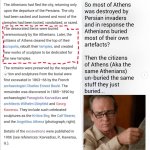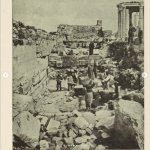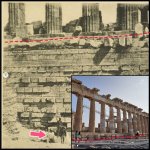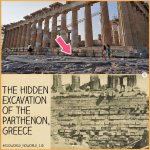KD: Before we start, I wanted to accuse Heinrich Schliemann of being one of the active contributors to the PTB narrative. The Big Boss does not even bother to stick his hand in his coat. He's got one of his subordinates do it for him. The image is Troy related, but falls within the time frame covering his presence at the Acropolis of Athens.

A few days ago, when I was putting this Hemi-Plunger ship article together, I noticed a greco-roman building in one of the ship related 19th century sources. I think coincidences of the below described nature, do not really happen. I apologize in advance, for I doubt my ability to put everything in a proper logical sequence. I will give it a try though.
The following (so-called) ancient structures will be discussed:

This here is the Acropolis Hill.

While there is evidence that the hill was inhabited as far back as the fourth millennium BC, it was Pericles (c. 495–429 BC) in the fifth century BC who coordinated the construction of the site's most important present remains including the Parthenon, the Propylaia, the Erechtheion and the Temple of Athena Nike.
Cremation, in this country at least, is not popular. For a time, it occupied here some public attention, but only in a sensational way; and the sober discussion of the subject, which followed after its novelty had worn off, led to the general opinion that, while every one might be quite willing to see his dead neighbors cremated, no one would acquiesce in the disposal of his friends and relatives in so abnormal a manner. Hence, with the single exception of the late revolting exhibition in Pennsylvania, which we alluded to at the time, the dead in this country have continued to be deposited in their hallowed resting places, and have not been packed away, in an incinerated state, in labeled urns. In Europe, however, cremation still finds many warm adherents; and during last summer a congress of the "Friends of Cremation" (a society which, we are informed by Engineering, whence we take the annexed engravings, has branches in various parts of the world), was held in Dresden. Before this meeting, a large number of designs for cremation and mortuary buildings were brought in competition, and finally the prize was awarded to Mr. G. Lilienthal, a Berlin architect, for the imposing structure illustrated herewith.
 This will be the grand temple of cremation when it is erected - a proceeding to take place in the dim future: when or where not stated. On each side of a central chapel there is a circular memorial hall; and extending so as to inclose the garden of the establishment, on the sides of the halls are wings containing a large number of niches for the reception of funeral urns.
This will be the grand temple of cremation when it is erected - a proceeding to take place in the dim future: when or where not stated. On each side of a central chapel there is a circular memorial hall; and extending so as to inclose the garden of the establishment, on the sides of the halls are wings containing a large number of niches for the reception of funeral urns.

KD: As you can see the description is incomplete, for only letters A, B, E and F were provided with a description. But my attention was attracted to the tower marked with a C at the bottom, and two bell-N's at the top. I have seen a similar tower before...

The tower was situated on the western corner of the Acropolis, next to the Propylaea, but probably did not communicate directly with them, as paintings and photographs from the 19th century show the entrance above ground, on the tower's eastern face at the second-floor level, some 6 metres (20 ft) above the architrave of the Propylaea. Literary sources attest to the fact that the door was accessible by means of an external wooden staircase. On the other hand, a couple of photographs also show a ground entrance on the western side, which means that the lower portion of the tower was probably separate from the upper, and used as a prison or storage room.

KD: This is why I accused Mr. Schliemann of being one of the narrative compilers. You see what he did? He facilitated the destruction of our medieval tower, because he wanted to clean-up of the Acropolis from post-Classical buildings. But today:

In other words, every single Acropolis building was built using the same construction material used to build this "medieval" tower. Schliemann was creating the myth of Antiquity by destroying the evidence of the Acropolis complex being something else...

KD: Construction began in 437 BC.

The Parthenon itself replaced an older temple of Athena, which historians call the Pre-Parthenon or Older Parthenon, that was destroyed in the Persian invasion of 480 BC. Like most Greek temples, the Parthenon served a practical purpose as the city treasury. For a time, it served as the treasury of the Delian League, which later became the Athenian Empire.

It was the most renowned cult image of Athens,considered one of the greatest achievements of the most acclaimed sculptor of ancient Greece. Phidias began his work around 447 BC. Lachares removed the gold sheets in 296 BC to pay his troops, and the bronze replacements for them were probably gilded thereafter; it was damaged by a fire about 165 BC but repaired. An account mentions it in Constantinople in the 10th century.

A modern copy (above) by Alan LeQuire stands in the reproduction of the Parthenon in Nashville, Tennessee. LeQuire, a Nashville native, was awarded the commission to produce the Parthenon's cult statue. His work was modeled on descriptions given of the original.
Summary of the construction dates:

Supply and demand would be something else for us to consider:
The below analysis of Gregorovius's 'History of Medieval Athens' appeared in the A. Fomenko's book titled 'Empirico-Statistical Analysis of Narrative Material and its Applications to Historical Dating.' The snippets were extracted from this edition.



Essentially, we have this little contradiction between the official description of the Athens, and the account provided by the 19th century historian Ferdinand Gregorovius.
As you can see, the Parthenon is being called Our Lady of Athens. In the final decade of the 6th century AD, the Parthenon was converted into a Christian church dedicated to the Virgin Mary. But it's this Akominatos that attracted my attention. A little bit of googling provided us with two Ἀκομινάτος dudes. They ended up being brothers. If it was not for their looks, I would not bother you with this info. Ours is Michael Akominatos.


One brother has something weird for his face (I assume it's himon his seal), the other one has two horn looking thingies. I just found it too interesting to ignore.
Nerio I Acciaioli
Fomenko and ParthenonAfter a lot of alleged mambo-jumbo, Athens and Acropolis ended up being allegedly conquered by Nerio I Acciaioli. Nerio's troops invaded the Duchy of Athens and occupied most parts of Attica and Boeotia in 1385.

They occupied the lower town of Athens, but could not capture the Acropolis from Dalmau's deputy, Raymond de Vilanova.

Anatoly Fomenko thinks that Nerio I was the one responsible for the construction of the Parthenon. Here is his reasoning for thinking that way.

I do not think I share this Fomenko's opinion about the Parthenon being built by Nerio I between 1387 and 1395. His opinion is definitely supported by the first known drawing of the Parthenon. The below drawing was allegedly done by Cyriacus of Ancona, aka Ciriacode Pizzicolli between 1436 and 1444.
As far as I understand the source of the above image is this 1883 book with the original being shown here. Somehow, one of the Parthenon Pediments look different on one two many images, but what else is new?

If the very first image of the Parthenon was indeed done between 1436 and 1444, this fact could make Fomenko's claim that much more credible. But just like I said, I disagree, and will try to cover my thoughts within the final summary.
For right now I wanted to briefly touch up on the Athena Parthenos statue. I always find images like the one below interesting. To be honest, most of the similar type images pertaining to this article do not look drastically different. It could be the issue with English language translations, or it could be whatever else. As it stands, Athena Parthenos was not mentioned in the English language sector until 1850.
The statue of Athena Parthenos somehow disappeared from Acropolis. Of course, we only learned about this statue's existence some time after 1400's. Wiki mentioned 1961 source says that "An account mentions it in Constantinople in the 10th century". The Nashville replica weighs 12 tons. I do not know how much 40 feet tall gold and ivory statue could weight, but getting it to Constantinople had to be a task to accomplish. Personally, I doubt there was ever such a statue of Athena-Minerva. On the other hand if there was, and it was really made of ivory and gold, we can all imagine the most likely fate of such statue.

KD Opinion: By now it appears that 15th century served as a major cutoff date. Prior to approximately 1400 AD, some major cataclysm drastically changed this world. It could have been the proverbial Biblical Deluge, a War of the Gods, or whatever else of comparable magnitude. Acropolis center somehow managed to avoid being destroyed, while nearby cities (or one large city Acropolis served) got wiped out or buried. Being elevated, Acropolis became a desirable complex worth fighting for, but it was not your regular complex of religious worship. In my opinion it served a rather practical purpose.
To get the point of my hypothesis across, I will re-post our 1877 Cremation Temple image with the Propylaea photograph superimposed. I think these two structures share the same design and the same purpose.

In my opinion, this design was developed prior to our pre-1400's event. Survivors inherited a lot of such remaining building/complex designs (and/or actual buildings), and this is why greco-roman architecture was so prevalent during the 19th century. They had designs meant to fulfill specific purposes, i.e. post offices, libraries, train stations, etc.
Here are a few 19th century examples:
The other notable, in my opinion, Acropolis structure is the above mentioned minaret, which most likely served as Crematorium. IMHO, it was something similar to the structure below.

You can look at some other beautiful crematorium designs (you might get surprised). The actual book from where I extracted the crematorium at Varese is here.
KD Summary: In order to prevent people from making the connection, Mr. Schliemann destroyed all the evidence of utility buildings present within theAcropolis complex.
P.S. On a separate note, I would not be surprised if pre-event factories looked no different...
A few days ago, when I was putting this Hemi-Plunger ship article together, I noticed a greco-roman building in one of the ship related 19th century sources. I think coincidences of the below described nature, do not really happen. I apologize in advance, for I doubt my ability to put everything in a proper logical sequence. I will give it a try though.
The following (so-called) ancient structures will be discussed:
- The Acropolis of Athens
- The Parthenon
- Athena Parthenos
- The Propylaea
- The Frankish Tower
- ... and a certain non-ancient 19th century Cremation Temple.
The Acropolis of Athens
The Acropolis of Athens is an ancient citadel located on a rocky outcrop above the city of Athens and contains the remains of several ancient buildings of great architectural and historic significance, the most famous being the Parthenon. The word acropolis is from the Greek words ἄκρον (akron, "highest point, extremity") and πόλις (polis, "city"). Although the term acropolis is generic and there are many other acropoleis in Greece, the significance of the Acropolis of Athens is such that it is commonly known as "The Acropolis" without qualification. During ancient times it was known also more properly as Cecropia, after the legendary serpent-man, Cecrops, the supposed first Athenian king.
- The construction date provided is 5th century BC. That would be approximately 2,500 years ago.
The Cremation Temple
19th century AD
I was gonna put this one at the very end, but just like I sad, I'm struggling with logically sequencing everything in this article. There is so much info I dug up, that it's somewhat hard. So when I was was throwing a quick Hemi-Plunger Ship article together I scrolled down this 02/24/1877 Scientific American Journal. And here is what I saw.19th century AD
Cremation, in this country at least, is not popular. For a time, it occupied here some public attention, but only in a sensational way; and the sober discussion of the subject, which followed after its novelty had worn off, led to the general opinion that, while every one might be quite willing to see his dead neighbors cremated, no one would acquiesce in the disposal of his friends and relatives in so abnormal a manner. Hence, with the single exception of the late revolting exhibition in Pennsylvania, which we alluded to at the time, the dead in this country have continued to be deposited in their hallowed resting places, and have not been packed away, in an incinerated state, in labeled urns. In Europe, however, cremation still finds many warm adherents; and during last summer a congress of the "Friends of Cremation" (a society which, we are informed by Engineering, whence we take the annexed engravings, has branches in various parts of the world), was held in Dresden. Before this meeting, a large number of designs for cremation and mortuary buildings were brought in competition, and finally the prize was awarded to Mr. G. Lilienthal, a Berlin architect, for the imposing structure illustrated herewith.
- The cremation ceremony is proposed to be as follows: The body, having been brought into the hall, is subjected to the usual medical examination; or when an inquest is necessary, it is removed to offices in another part of the building, where the required investigation can be held.
- When all is ready, the body, placed on the platform, B, Fig. 2, is raised by a lift into the hall, A, where visitors are gathered, and here the result of the medical examination is declared, and whatever preliminary religious ceremonies that are desired are performed.
- The body is then transported to the chapel, E, in front of the pulpit, F, where the burial service is performed.
- The bier is afterward lowered mechanically, and brought to the furnaces, which are arranged in a semicircle and partitioned for the reception of several biers.
- The ashes are subsequently placed in an urn, on which the name, etc., of the deceased are recorded, and which is set up in a suitable niche.
- The building, which we illustrate both in elevation, Fig. 1, and in plan, Fig. 2, is designed to contain 100,000 urns, and is adapted for a town of 200,000 inhabitants. The architect has certainly exhibited much taste in his design for the building, and has provided every convenience in the internal arrangement for carrying on a large business in the cremation line.
KD: As you can see the description is incomplete, for only letters A, B, E and F were provided with a description. But my attention was attracted to the tower marked with a C at the bottom, and two bell-N's at the top. I have seen a similar tower before...
The Frankish Tower
The Frankish Tower (part of the Propylaea) was a medieval tower built on the Acropolis of Athens by the Franks as part of the palace of the Dukes of Athens. It was demolished by the Greek authorities in 1874, on the initiative and with funding from Heinrich Schliemann.- The date of construction is unclear, and following its demolition now impossible to reconstruct with any certainty.
- Construction is usually ascribed to the Acciaioli family, who ruled the Duchy of Athens between 1388 and its fall to the Ottoman Empire in 1458, since it was they who converted the Propylaea complex into a palace.
- However, according to medievalist Peter Lock, the tower "might equally be ascribed" to the first dynasty of Frankish dukes of Athens, the 13th-century de la Roche, who also had a residence on the site, of which no details are known.
- The tower was dismantled in 1874, as part of a wider cleaning-up of the Acropolis from post-Classical buildings, a project initiated and financed by Heinrich Schliemann.
- The demolition of such an "integral part of the Athenian horizon" (Théophile Gautier) drew considerable criticism at the time.
- Work began on 2 July, amid great publicity organised by Schliemann, but a few days later the demolition was halted at the order of King George I, prompting Schliemann to write an indignant letter of protest to the King.
- Despite the latter's opposition, the tower was eventually torn down.
- The eminent historian of Frankish Greece William Miller later called it "an act of vandalism unworthy of any people imbued with a sense of the continuity of history", and "pedantic barbarism".
- The tower was built of stone from the quarries of Penteli and Piraeus, making heavy use of material from the ancient buildings of the Acropolis. It was square in shape, 28.5 feet (8.7 m) long and 25.5 feet (7.8 m) wide, and its walls had a thickness of 5.75 feet (1.75 m) at their base. With a height of 85 feet (26 m), its top, accessible through a wooden staircase, held a commanding view over the central plain of Attica and the surrounding mountains. The north side of the tower had a small, square turret that projected from the wall, atop which "beacon-fires could be kindled which would be visible from Acrocorinth" in the Peloponnese.
- Old sketches from the late 17th century on also show that the tower was crenellated.
- The date of construction is unclear, and following its demolition now impossible to reconstruct with any certainty.
- The tower was built of stone from the quarries of Penteli and Piraeus, making heavy use of material from the ancient buildings of the Acropolis.
In other words, every single Acropolis building was built using the same construction material used to build this "medieval" tower. Schliemann was creating the myth of Antiquity by destroying the evidence of the Acropolis complex being something else...
- The tower was allegedly built between 1388 and 1458, but... "the date of construction is unclear."
The Propylaea
The Propylaea was the monumental gateway to the Acropolis of Athens, and was one of several public works commissioned by the Athenian leader Pericles in order to rebuild the Acropolis a generation after the conclusion of the Persian Wars. Pericles appointed his friend Phidias as the supervisor and lead architect of this massive project, which Pericles allegedly financed with funds appropriated from the treasury of the Delian League. According to Plutarch, the Propylaea was designed by the architect Mnesikles, about whom nothing else is known. Construction began in 437 BC and was terminated in 432, when the building was still unfinished.
We can use one of the above images to illustrate our Propylaea, for that image is titled:
The Parthenon
The Parthenon is a former temple on the Athenian Acropolis, Greece, dedicated to the goddess Athena, whom the people of Athens considered their patron. Construction began in 447 BC when the Athenian Empire was at the peak of its power. It was completed in 438 BC, although decoration of the building continued until 432 BC. It is the most important surviving building of Classical Greece. Its decorative sculptures are considered some of the high points of Greek art. The Parthenon is regarded as an enduring symbol of Ancient Greece, Athenian democracy and Western civilization, and one of the world's greatest cultural monuments. To the Athenians who built it, the Parthenon and other Periclean monuments of the Acropolis were seen fundamentally as a celebration of Hellenic victory over the Persian invaders and as a thanksgiving to the gods for that victory.
- In the final decade of the 6th century AD, the Parthenon was converted into a Christian church dedicated to the Virgin Mary.
- After the Ottoman conquest, it was turned into a mosque in the early 1460s.
- On 26 September 1687, an Ottoman ammunition dump inside the building was ignited by Venetian bombardment during a siege of the Acropolis. The resulting explosion severely damaged the Parthenon and its sculptures.
- From 1800 to 1803, Thomas Bruce, 7th Earl of Elgin removed some of the surviving sculptures, now known as the Elgin Marbles, with the alleged permission of the Turks of the Ottoman Empire.
- Since 1975 numerous large-scale restoration projects have been undertaken; the latest is expected to finish in 2020.
Athena Parthenos
Athena Parthenos is a lost massive chryselephantine (gold and ivory) sculpture of the Greek goddess Athena, made by Phidias and his assistants and housed in the Parthenon in Athens; this statue was designed as its focal point. Parthenos 'maiden, virgin' was an epithet of Athena. There have been many replicas and works inspired by the statue, in both ancient and modern times.It was the most renowned cult image of Athens,considered one of the greatest achievements of the most acclaimed sculptor of ancient Greece. Phidias began his work around 447 BC. Lachares removed the gold sheets in 296 BC to pay his troops, and the bronze replacements for them were probably gilded thereafter; it was damaged by a fire about 165 BC but repaired. An account mentions it in Constantinople in the 10th century.
A modern copy (above) by Alan LeQuire stands in the reproduction of the Parthenon in Nashville, Tennessee. LeQuire, a Nashville native, was awarded the commission to produce the Parthenon's cult statue. His work was modeled on descriptions given of the original.
- The modern version took eight years to complete, and was unveiled to the public on May 20, 1990.
- The Nashville Athena Parthenos is made of a composite of gypsum cement and ground fiberglass.
- The head of Athena was assembled over an aluminum armature, and the lower part was made in steel.
- The four ten-inch H beams rest on a concrete structure that extends through the Parthenon floor and basement down to bedrock, to support the great weight of the statue.
- LeQuire made each of the 180 cast gypsum panels used to create the statue light enough to be lifted by one person and attached to the steel armature.
- Nashville's Athena stands 41 ft 10 in (12.75 m) tall, making her the largest piece of indoor sculpture in the Western World.
- It stood in Nashville's Parthenon as a plain, white statue for twelve years.
- In 2002, Parthenon volunteers gilded Athena under the supervision of master gilder Lou Reed.
- The gilding project took less than four months and makes the modern statue appear that much more like the way that Phidias' Athena Parthenos would have appeared during its time.
- The 23.75-karat gold leaf on Nashville's Athena Parthenos weighs a total of 8.5 pounds (3.9 kg) and is one-third the thickness of tissue paper.
Summary of the construction dates:
- Acropolis: 5th century BC
- Parthenon: 447 BC - 448 BC
- Propylaea: began in 437 BC
- Athena Parthenos: began around 447 BC.
- Frankish Tower: built between 1388 and 1458, but... "the date of construction is unclear."
- Cremation Temple: design was presented in 1877 AD, unknown if built.
Antiquity
As was stated above, I think the Frankish Tower was a part of the original Propylaea/Acropolis design. It was destroyed by Schliemann to preserve the "looks of antiquity." The Tower did not fit the general accepted appearance of the greco-roman structures. Before we get into some inconsistencies pertaining to the history of Greece, Athens and Acropolis, there is one important thing to remember:- Ancient Greece (Archaic, Classical, Hellenistic) spanned from 8th century BC to 149 BC.
- There are no original sources of anything pertaining to Ancient Greece.
- This world knew nothing about ancient Greece until the beginning of the 15th century.
- Example: The Odyssey is widely believed to date back to the Eighth Century B.C., with the story being told in the oral tradition before it was eventually inscribed.
- Everything we know about ancient Greece was obtained through copies of non-existent originals which miraculously appeared in the beginning of the 15th century.
- Example: Prior to the 15th century, copies of the Odyssey were handwritten in Greek, and the first printed version, also transcribed in Greek, was produced in 1488.
- I used the Odyssey as an example. The same 16th century pattern pertains to every single ancient Greek text we have. You are more then welcome to verify for yourself.
- Essentially it means two things:
- For approximately 2,000 years this world did not know anything about ancient Greece.
- For approximately 2,000 years copies were getting preserved, and nobody knew about them.
- People like Poggio Bracciolini and his agent Nicola Nicolli were some of the very first providers of the so-called antique manuscripts. The snippet below is meant to illustrate the common pattern of how we learned about our "ancient" past.
- An additional aspect of the market for 16th-century Greek manuscripts was an increasing desire for high-quality calligraphic manuscripts on the part of wealthy patrons, especially the French aristocracy.
- Greek manuscripts continued to be produced in substantial quantities long after the introduction of print.
- The increased need for manuscripts also resulted in the migration of talented Greek scribes to France.
Ancient Greece & Athens
Have you ever wondered where all the "ancient Greeks" go? Let us see what a German historian Ferdinand Gregorovius had to say.The below analysis of Gregorovius's 'History of Medieval Athens' appeared in the A. Fomenko's book titled 'Empirico-Statistical Analysis of Narrative Material and its Applications to Historical Dating.' The snippets were extracted from this edition.
- TPTB: Athens dominates the Attica region and is one of the world's oldest cities, with its recorded history spanning over 3,400 years and its earliest human presence started somewhere between the 11th and 7th millennium BC.
- FG: Medieval Athens first appeared on the arena of history after many years of nonexistence as a small Byzantine fortress...
Castle of Sathines
Apparently, our Acropolis was also known as The Castle of Sathines. I was unable to find any specific information about this name. There has to be a meaning to this "Sathines" but a correct search string keeps on escaping me.As you can see, the Parthenon is being called Our Lady of Athens. In the final decade of the 6th century AD, the Parthenon was converted into a Christian church dedicated to the Virgin Mary. But it's this Akominatos that attracted my attention. A little bit of googling provided us with two Ἀκομινάτος dudes. They ended up being brothers. If it was not for their looks, I would not bother you with this info. Ours is Michael Akominatos.
- Michael Ἀκομινάτος was a Byzantine writer and ecclesiastic. At an early age he studied at Constantinople and was the pupil of Eustathius of Thessalonica. Around 1175 he was appointed archbishop of Athens, a position which he retained until 1204. In 1204, he defended the Acropolis of Athens from attack by Leo Sgouros, holding out until the arrival of the Crusaders in 1205, to whom he surrendered the city
- Niketas Ἀκομινάτος was a Byzantine government official and historian – like his brother Michael Akominatos, whom he accompanied to Constantinople. Niketas wrote a history of the Eastern Roman Empire from 1118 to 1207.
Nerio I Acciaioli
Fomenko and Parthenon
They occupied the lower town of Athens, but could not capture the Acropolis from Dalmau's deputy, Raymond de Vilanova.
- Nerio's troops captured the Acropolis on 2 May 1388, putting an end to the Catalans' rule in the Duchy of Athens.
As far as I understand the source of the above image is this 1883 book with the original being shown here. Somehow, one of the Parthenon Pediments look different on one two many images, but what else is new?
For right now I wanted to briefly touch up on the Athena Parthenos statue. I always find images like the one below interesting. To be honest, most of the similar type images pertaining to this article do not look drastically different. It could be the issue with English language translations, or it could be whatever else. As it stands, Athena Parthenos was not mentioned in the English language sector until 1850.
The statue of Athena Parthenos somehow disappeared from Acropolis. Of course, we only learned about this statue's existence some time after 1400's. Wiki mentioned 1961 source says that "An account mentions it in Constantinople in the 10th century". The Nashville replica weighs 12 tons. I do not know how much 40 feet tall gold and ivory statue could weight, but getting it to Constantinople had to be a task to accomplish. Personally, I doubt there was ever such a statue of Athena-Minerva. On the other hand if there was, and it was really made of ivory and gold, we can all imagine the most likely fate of such statue.
The Mosque
I am not gonna go too deep into this alleged mosque thing. I do not think it was designed as a mosque. The Ottomans might have used it as a mosque, but I don't think it was originally a mosque. TPTB insists the story goes, like this:- In 1456, Ottoman Turkish forces invaded Athens and laid siege to a Florentine army defending the Acropolis until June 1458, when it surrendered to the Turks.
- The Turks may have briefly restored the Parthenon to the Greek Orthodox Christians for continued use as a church.
- Some time before the close of the fifteenth century, the Parthenon became a mosque.
- The precise circumstances under which the Turks appropriated it for use as a mosque are unclear; one account states that Mehmed II ordered its conversion as punishment for an Athenian plot against Ottoman rule.
- Despite the alterations accompanying the Parthenon's conversion into a church and subsequently a mosque, its structure had remained basically intact.
- Some time in the 18th century there could have been a second mosque built within the ruins, but that's not the same as on the image below.
KD Opinion: By now it appears that 15th century served as a major cutoff date. Prior to approximately 1400 AD, some major cataclysm drastically changed this world. It could have been the proverbial Biblical Deluge, a War of the Gods, or whatever else of comparable magnitude. Acropolis center somehow managed to avoid being destroyed, while nearby cities (or one large city Acropolis served) got wiped out or buried. Being elevated, Acropolis became a desirable complex worth fighting for, but it was not your regular complex of religious worship. In my opinion it served a rather practical purpose.
To get the point of my hypothesis across, I will re-post our 1877 Cremation Temple image with the Propylaea photograph superimposed. I think these two structures share the same design and the same purpose.
In my opinion, this design was developed prior to our pre-1400's event. Survivors inherited a lot of such remaining building/complex designs (and/or actual buildings), and this is why greco-roman architecture was so prevalent during the 19th century. They had designs meant to fulfill specific purposes, i.e. post offices, libraries, train stations, etc.
Here are a few 19th century examples:
- Pennsylvania Station (1910–1963) - Wikipedia
- Iowa State Capitol - Wikipedia
- Library of Congress - Wikipedia
The other notable, in my opinion, Acropolis structure is the above mentioned minaret, which most likely served as Crematorium. IMHO, it was something similar to the structure below.
KD Summary: In order to prevent people from making the connection, Mr. Schliemann destroyed all the evidence of utility buildings present within the
- Necropolis is a large, designed cemetery with elaborate tomb monuments. The name stems from the Ancient Greek νεκρόπολις nekropolis, literally meaning "city of the dead".
- The term usually implies a separate burial site at a distance from a city, as opposed to tombs within cities, which were common in various places and periods of history.
What do you think this is?

P.S. On a separate note, I would not be surprised if pre-event factories looked no different...













